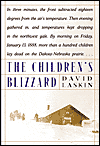The Children's Blizzard

I just finished reading David Laskin’s The Children’s Blizzard. If you grew up in the upper-midwest like I did you will find it enjoyable and interesting in a way that readers from other locales, at least in my opinion, will not be able to connect with.
First off, you need to read this book in the winter. Winter is leaving us now so if you are just finding out about it and really want to read it either do so quickly or put it on your list for January of 2006. Reading this book in the sunny days of summer would take an edge, a bitter reminder, away from the story. Secondly, I would suggest reading it in the winter and in a nice warm room with a good blanket. As you read about one of the worst blizzards in the history of the plains and the death that was left behind you would be well served by being nice and warm.
While reading The Children’s Blizzard I kept on thinking back to reading Young Men and Fire by Norman MacLean. Both authors seem to have an ability to describe the most mundane details or dry topics in a way that genuinely captures your interest. They share the ability to write pages of text regarding developing weather conditions that somehow grab the reader. Similar to Children’s Blizzard, Young Men and Fire is best read in the right place. For me, it was largely in a tent while camping in the woods. Perfect.
The similarities for me didn’t stop there. Both of these books recount a tragic event. Both of them describe events that only happened because of amazingly rare and unlikely combinations of events. Both of them go into amazing detail on the events that happened just before and just after the event. Both of them are very well written. Both of them leave you feeling pretty lucky.
Children’s Blizzard is about the worst blizzard to ever hit the plains. It struck in January 12 of 1888. It is called the Children’s Blizzard because it struck across the majority of the plains in the middle of a day that started in the 20s to 40s. Hundreds of children in country schoolhouses in Dakota and the rest of the plains were forced out into the blizzard. Hundreds of those same children died in a storm that was so intense that it dropped the temperature 40 degrees in 4 hours and had steady winds in excess of 50 miles per hour. A storm so intense that some cattle suffocated to death because the snow filled in their nostrils and they were unable to breath!
I found it surprising that I had never heard of this storm. Hundreds of children died in the storm and hundreds died after due to complications from amputation and other “treatments” for problems from the storm. Fathers died while holding their child, the child surviving the night because of the weather-break provided by their dead fathers body. This is brutal stuff and I had never heard of it. Granted this is 100 years ago but this is a big thing and should still reverberate in the culture of places like North Dakota where I grew up. At the end the book goes into a bit of why this tragic event was forgotten in practically one generation. I’ll leave it for you to read and get all the details.
Grab a copy of this book. Light a fire and enjoy life on the “modern prairie”. Be happy you don’t live in a “soddie”.